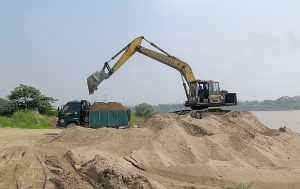What are The Mineral Rights in Real Estate, and How Do They Work?
[Editor’s Note: Today’s article is a guest post from Pheasant Energy. Pheasant Energy is a Fort Worth based upstream oil and gas company. Their primary focus is in the mineral, royalty, and working interest subset of the industry. They analyze a high rate of opportunities and have a proven history of transacting quicker than anyone in the industry. ]
If you like making profits from land that you didn’t need to take any action on, investing in mineral rights might be a good option for your next real estate venture.
The investment in mineral rights has the potential to yield huge yields. The language, rules, negotiation, classifications, and terminology differ from a typical real estate transaction.
This article will provide you with fundamental knowledge on how Real Estate investing can earn money from mineral rights.
Don’t Miss Any Updates. Each week I’ll send you advice on how to reach financial independence with passive income from real estate.
Sign up for my newsletterWhat Are Mineral Rights?
Mineral rights refer to the rights of underground resources such as:
- natural gas
- oil
- copper
- gold
- silver
- coal
- iron
- uranium
- many other minerals
However, limestone, sand, gravel, and subsurface water are not considered mineral rights and usually belong to the surface rights holder.
If you sell your mineral rights to the real estate, you’re only the landowner above. If the mineral rights owner wants to extract resources, they don’t require your permission to conduct this.
They could conduct exploratory drilling and other tests to decide if they wish to invest further in development. They’ll construct infrastructure and equipment like pumps and mine shafts.
Do you have a loved one who may need the owner of mineral rights to compensate for any surface damages? They may use the area as they believe it necessary to explore and extract mineral resources without asking permission.
That’ll affect how you view your property and ability to use the land in the ways you think are appropriate.
4 Types of Mineral Rights
Today, it’s common practice to separate mineral rights on the property from the parcel of land.
Here’s the 4 main types of mineral rights:
#1. Surface Rights
Surfaces rights are the rights to the surface area of a piece of land as well as any structures on the property.
Surface rights also include farmland or above-ground resources like trees, plants, or water.
Not included are rights to minerals in the subsurface.
#2. Mineral Interests
This refers to the ownership of mineral rights which allow:
- exploration
- exploitation
- mineral production activities
An individual can obtain mineral rights associated with a property, and in this case, can sever the surface rights from the mineral rights.
For example, by doing this, landmen or other representatives of oil, gas, coal, or energy companies can acquire the mineral rights. But the landowner retains authority over the surface area of the tracts of land in question.
Owners of subsurface rights can receive royalty, lease, and shut-in payments.
#3. Royalty Rights
An investor who earns a stream of royalty payments on mineral rights is the owner of oil and gas royalty rights. They receive a share of the income as the minerals are produced from the leased property.
#4. Oil and Gas Rights
The fluidity of gas and oil makes it hard to define mineral rights by a defined well or geographic area. Oil can easily flow and spread to the subsurface of neighboring tracts of land.
The right known as the “rule of capture” means that the fluid minerals that flow between properties may be extracted from any property under which they move. These are called fugitive resources.
For instance, if you have the mineral rights to drill a well on neighbor #1’s property, you have a right to all the oil captured, even if the oil is drawn from the adjoining properties of neighbor #2 and #3.
How Do Mineral Rights Work?
Mineral rights owners can explore and develop the land they own rights to in search of minerals or sell their rights to private businesses or other organizations to explore and exploit.
If they sell rights, holders may receive payment via leases, royalties, or shut-in compensation (when the well capable of producing isn’t used).
There are usually specific clauses that are found in these sales contracts. These provisions outline the agreement for sale and may function as contingencies used in the home sale. The most frequent requirements are:
#1. Conveyance
Outlining the cost for particular minerals and net profits and royalty interests derived by the land.
#2. Diligence
This term creates a time frame that prohibits an owner from selling rights to a third party when the buyer owns the title. The contract also contains a clause that outlines how and when the sale price can be adjusted if needed.
This clause permits the buyer to opt off the purchase if there is a problem with the title or rights.
#3. Closing
This section spells out the:
- closing type
- timing, cost
- tax details
Surface Rights vs Rights to Mineral Rights
Surface rights are the rights you own on top of your property. They include the land and the structures and landscaping.
Mineral rights have particular sources below the surface.
It’s typical for mineral rights and surface rights to be distinct in the areas designated for mining. It’s possible to be in an instance where you have the surface rights but not mineral rights.
We know it as a “severed estate” (see the section below on how mineral rights are held).
How Are Mineral Rights Held?
There are many ways in which mineral rights can be used. We know the mixture of minerals rights and surface rights as an estate. The way these estates are governed will differ from location to place.
Here are some kinds of estates:
- Unified Estate: Unified Estate in which mineral rights and surface rights are connected.
- Severed Estate: Ownership of mineral rights and surface rights could be distinct.
- Fractional Estate: One Estate is the owner of part of mineral rights.
Commonly Asked Questions Concerning Mineral Rights
Also, do these rights transfer along with the property? Or are they different? Here are a few answers to frequently asked questions regarding mineral rights.
#1. How long do mineral interests last?
Mineral interests are indefinite, so long as they’re not abandoned. They are left if they’re not used or claimed for 20 years. They are “used” when a particular activity like leasing, production, or conveying takes place following North Dakota law.
Mineral interest owners may also prove theirs occur according to a comprehensive document known as a Statement Claim. It will protect the mineral interest from being declared abandoned even if they’re not used for up to 20 years.
#2. Can mineral interests be lost?
As mentioned above, if mineral rights are abandoned or not claimed for longer than 20 years, they’re deemed abandoned.
An owner of the land on the surface can sue in court to get the rights to abandoned minerals on their property. Mineral owners have the chance to respond to this request, but often the legitimate owners of mineral rights may not know of its existence.
#3. What do I need to know whether I’ve got mineral rights on my property?
Like the land, a deed can transfer mineral rights, transferring ownership to the purchaser. Although the deed to the property will mention the transfer upon the land is separated from mineral rights is completed, the subsequent sales of the ground won’t.
To determine whether you hold mineral rights, you must look up mineral rights records. The municipal or county land title registry office does not record these rights title deeds.
A lawyer or another title searcher referred to as Landmen, who specializes in mineral rights research, will carry out the investigation.
#4. How can I get my mineral rights?
If you’re a landowner, the court action for abandoned minerals, as mentioned earlier, is a way to gain mineral rights.
Many are handed down through families and deeded either directly or through probate.
Bottom Line
Mineral rights could earn excellent returns or even an ongoing, steady income. They require specialist information. Market volatility could transform a good deal into a complete loss in months. It’s essential to carefully consider the real estate’s use for different services.
Determine the goal and select the right team, and you’ll be well on your path to huge returns from mineral rights.
Join the Passive Investors Circle


